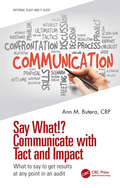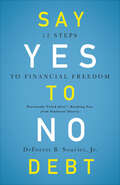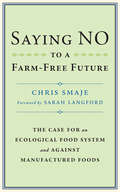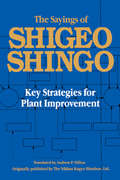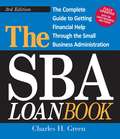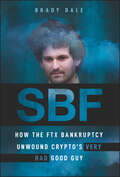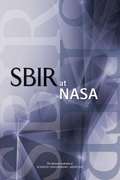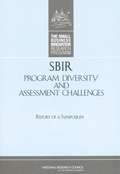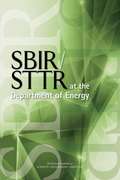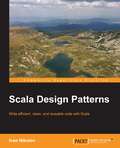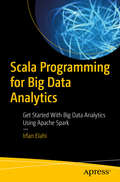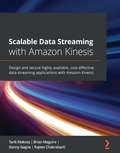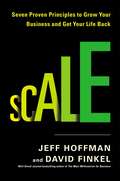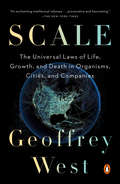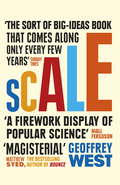- Table View
- List View
Say What!? Communicate with Tact and Impact: What to say to get results at any point in an audit (Internal Audit and IT Audit)
by Ann M. ButeraThis book addresses the important role of communication within the context of performing an audit, project, or review (i.e., planning, detailed testing, and reporting). Intended for audit, information security, enterprise, and operational risk professionals at all levels, including those just starting out, Say What!? Communicate with Tact and Impact: What to Say to Get Results at Any Point in an Audit contains an array of practical and time-tested approaches that foster efficient and effective communication at any point during an engagement. The practical and memorable techniques are culled from author Ann M. Butera’s CRP experience as a trusted advisor who has taught thousands of professionals how to develop and hone their interpersonal, communication, and empathic skills. Those familiar with the Five Tier Competency ModelTM she developed will recognize these techniques as a deep dive on the competencies comprising Tier 3: Project Management and Tier 5: Managing Constituent Relations. The author discusses the following behaviors in one’s dealings with executives, process owners, control performers, and colleagues: Demonstrating executive presence Becoming the trusted advisor Influencing others Communicating with tact, confidence, and impact Facilitating productive meetings and discussions Overcoming resistance and objections Managing and resolving conflict Knowing when to let a topic go and move on This book is a guide for professionals who want to interact proactively and persuasively with those they work with, audit, or review. It describes techniques that can be used during virtual, in-person, telephone, or video conferences (as opposed to emails, workpapers, and reports). It provides everyone (newer associates in particular) with the interpersonal skills needed to (1) develop and build relationships with their internal constituents and clients, (2) facilitate conversations and discussions before and during meetings, and (3) handle impromptu questions with confidence and executive presence and make positive first impressions. The topics and techniques discussed are accompanied by case studies, examples, and exercises to give the readers the opportunity to develop plans to bridge the gap between theory and practice. The readers can use the book as a reliable resource when subject matter experts or training guides are not readily available.
Say Yes to No Debt: 12 Steps to Financial Freedom
by DeForest B. Soaries Jr.The founder of the dfree™ movement's twelve attainable steps to financial freedom. This book is not just another financial literacy program that assumes that all people need is information. Drawing on his personal experience and years as a pastor, public policy maker, and community leader, DeForest "Buster" Soaries, Jr. shares a groundbreaking, life-changing approach to financial wellness that views financial bondage as an emotional, spiritual, and psychological problem.The dfree™ movement provides twelve easy, attainable steps to help you:Get started on your debt by admitting the problem, addressing the mess, and adjusting your attitudeGet control by creating a spending plan, becoming accountable, and setting goalsGet ahead by building wealth, planning your will and estate, and celebrating your successAnd give back by investing in others, through tithing, mentoring, and leading your own dfree™ movementIf you want to live a debt-free life with the financial freedom to travel, purchase a home within your means, and enjoy retirement without the burden of pay excess monthly bills, then this book is for you.Eliminating debt is the first step toward financial freedom. And YOU can do it.
Say Yes When Life Says No
by Dr. DeForest B. Soaries Jr.Many people understand what it feels like when life continually throws obstacles, prejudice, hardship, and economic challenge in what seems an endless string of misfortune. It can feel like life constantly challenges us with “no” in the form of:LonelinessJudgmentNegativitySicknessDeath, and moreBut when we draw on the same faith as the blind man in John Chapter 9, we learn to trust that Jesus will know our plight, show up and give us what we need to not only turn our life course, but to also have our hearts sing “yes!”Drawn from the remarkable life experiences of one man, Say Yes When Life Says No includes a first-hand account of Rev. Dr. DeForest Soaries – pastor, husband, father, public servant, and cancer survivor. Enriched with personal stories and vivid Biblical references, Dr. Soaries provokes us to see every obstacle in life as an opportunity and every burden as a potential blessing.
Saying It Well: Touching Others with Your Words
by Charles R. SwindollBestselling author and master communicator Charles Swindoll has been effectively speaking to others for over fifty years. In SAYING IT WELL: Touching Others With Your Words he shares his secrets on how to talk so people will listen. Filled with techniques, stories, and models that clearly explain the formulas for successful speaking, Swindoll teaches readers the foundational principles for how to communicate, from preparing for a speech, organizing thoughts, and filtering out the superfluous to overcoming fears, grabbing the listener's attention, and knowing how and when to stop. With humorous stories and inventive, practical tips, one of America's premier communicators shares decades of experience on how to speak with authority in every situation, persuade others to consider the reader's perspective, overcome the reader's fears of public speaking, and love others more effectively with the reader's words. He also shares his personal story and the journey to becoming a world-famous speaker.nner...and frankly, how and when to stop. The book will be written for professional speakers and pastors as well as regular people who may be teachers or in a business who are called on from time to time to deliver a verbal presentation. With humorous stories and inventive, practical tips, one of America's premier communicators shows the reader how to speak with authority in every situation, persuade others to consider the reader's perspective, overcome the reader's fears of public speaking, and love others more effectively with the reader's words.
Saying NO to a Farm-Free Future: The Case For an Ecological Food System and Against Manufactured Foods
by Chris Smaje“Everyone in the food business needs to read this book. . . . [A] lively and superbly written polemic.”—Joel Salatin, co-founder of Polyface Farm A defense of agroecological, small-scale farming and a robust critique of an industrialized future. One of the few voices to challenge The Guardian's George Monbiot on the future of food and farming (and the restoration of nature) is academic, farmer and author of A Small Farm Future Chris Smaje. In Saying NO to a Farm-Free Future, Smaje presents his defense of small-scale farming and a robust critique of Monbiot’s vision for an urban and industrialized future. Responding to Monbiot’s portrayal of an urban, high-energy, industrially manufactured food future as the answer to our current crises, and its unchallenged acceptance within the environmental discourse, Smaje was compelled to challenge Monbiot’s evidence and conclusions. At the same time, Smaje presents his powerful counterargument – a low-carbon agrarian localism that puts power in the hands of local communities, not high-tech corporates. In the ongoing fight for our food future, this book will help you to understand the difference between a congenial, ecological living and a dystopian, factory-centered existence. A must-read! "Chris Smaje has laid down an indictment – as unremitting as it is undeniable – that cuts through the jargon-filled, techno-worshipping agricultural futurists who promise silver-bullet fixes for having your cake and eating it too. This brilliant and compelling book is at once hopeful and persuasive about the future of food."—Dan Barber, chef at Blue Hill and author of The Third Plate
The Sayings of Shigeo Shingo: Key Strategies for Plant Improvement
by Shigeo ShingoHere is a great introduction to the remarkable mind of Shigeo Shingo, indisputably one of the great forces in manufacturing. In this soft cover book, Dr. Shingo describes his approach to manufacturing improvements, developed and refined over the course of a brilliant career. He called it the Scientific Thinking Mechanism (STM). The Sayings of Shigeo Shingo leads you through the five stages of STM, with appropriate examples taken from notes Dr. Shingo collected during his consulting trips to American and Japanese plants. It shows how, in many cases, the most brilliant ideas are often so simple they're overlooked. Or they're dismissed because they seem ridiculous: - A Japanese plant, after first rejecting the idea as too silly, finds that unhulled rice is ideal for smoothing the rough surfaces on pressure-formed ebonite switches - Granville-Phillips, in Boulder, Colorado, reduced defects to zero in one process after Dr. Shingo suggested illuminating circuit boards from below to reduce errors involved in the insertion of diodes and resistors The Sayings of Shigeo Shingo is must reading for plant managers and engineers. It formalizes the powerful and creative way of thinking that Shingo himself used time and again to overcome problems that seemed virtually insurmountable.
The Sayings of Shigeo Shingo: Key Strategies for Plant Improvement
by Shigeo ShingoHere is a great introduction to the remarkable mind of Shigeo Shingo, indisputably one of the great forces in manufacturing. In this book Dr. Shingo describes his approach to manufacturing improvements, developed and refined over the course of a brilliant career. He called it the Scientific Thinking Mechanism (STM).The Sayings of Shigeo Shingo leads you through the five stages of STM, with appropriate examples taken from notes Dr. Shingo collected during his consulting trips to American and Japanese plants. It shows how, in many cases, the most brilliant ideas are often so simple they're overlooked. Or they're dismissed because they seem ridiculous:A Japanese plant, after first rejecting the idea as ""too silly,"" finds that unhulled rice is ideal for smoothing the rough surfaces on pressure-formed ebonite switchesGranville-Phillips, in Boulder, Colorado, reduced defects to zero in one process after Dr. Shingo suggested illuminating circuit boards from below to reduce errors involved in the insertion of diodes and resistorsThe Sayings of Shigeo Shingo is must reading for plant managers and engineers. It formalizes the powerful and creative way of thinking that Shingo himself used time and again to overcome problems that seemed virtually insurmountable.
The SBA Loan Book
by Charles H. GreenSpurred by President Obama, the Small Business Association has stepped up its loan program to companies around the nation. But to receive an SBA-guaranteed loan, firms must navigate a complex course of processes, qualifications, documentation, and approvals.You need this new edition of Charles Green's invaluable book to chart the best way to apply for and get an SBA loan. Green wastes no time in showing: Why an SBA loan guarantee is a good option in tough economic timesHow to choose the right bank at a time when many banks have failed and credit is tightWhat the new rules and regulations say about the paperwork and documentation loan applicants must supplyIn today's turbulent economic climate, solid financial backing is the key to small business survival. And this fully updated guide to SBA loans will help you land it.
The SBA Loan Book: The Complete Guide to Getting Financial Help Through the Small Business Administration
by Charles H GreenSpurred by President Obama, the Small Business Association has stepped up its loan program to companies around the nation. But to receive an SBA-guaranteed loan, firms must navigate a complex course of processes, qualifications, documentation, and approvals.You need this new edition of Charles Green's invaluable book to chart the best way to apply for and get an SBA loan. Green wastes no time in showing:Why an SBA loan guarantee is a good option in tough economic timesHow to choose the right bank at a time when many banks have failed and credit is tightWhat the new rules and regulations say about the paperwork and documentation loan applicants must supplyIn today's turbulent economic climate, solid financial backing is the key to small business survival. And this fully updated guide to SBA loans will help you land it.
The SBA LOAN BOOK 3rd Edition
by Charles H. GreenToday, more businesses than ever before are seeking loans backed by the Small Business Association. But to receive an SBA-guaranteed loan, you'll have to successfully navigate a series of complex qualifications, documentation, and approvals. The newest edition of Charles Green's invaluable guide will help you find the best loan for your business and assemble all the documentation you'll need to get it. Inside, he breaks down: Why an SBA loan guarantee is a good option in a tough economy How to choose the right bank at a time when many banks have failed and credit is tight What the new rules and regulations say about the paperwork and documentation you must supply Solid financial backing is the key to small business survival. This fully updated guide to SBA loans takes the guesswork out of a complicated application process and increases your odds of securing the money you need.
SBF: How The FTX Bankruptcy Unwound Crypto's Very Bad Good Guy
by Brady DaleA first-hand look at the extraordinary collapse of FTX, Alameda Research, and Sam Bankman-Fried In SBF: How the FTX Bankruptcy Unwound Crypto’s Very Bad Good Guy, accomplished crypto reporter Brady Dale presents an engrossing take on the spectacular and sudden implosion of FTX, Alameda Research, and their associated companies, as well as the criminal indictments of Sam Bankman-Fried and several of his associates. In the book, you’ll go beyond the salacious details and tawdry gossip to grasp the real lessons to be learned from one of the most dramatic corporate failures in living memory. The author explores: The often-confusing world of cryptocurrency and decentralized finance, offering a deep understanding of both industries The history of Sam Bankman-Fried, what smart money players had to say about him in 2019 and 2020, and why many decentralized finance professionals considered him a “pirate” even before FTX and Alameda blew up What the aggressive lobbying campaigns waged by FTX and Sam Bankman-Fried reveal about the latter’s motives and goalsAn extraordinary account of almost unimaginable wealth, greed, and hubris, SBF is a can’t-miss account of a fascinating corporate tragedy that continues to unfold to this very day.
Sbir And The Phase Iii Challenge Of Commercialization: Report Of A Symposium
by National Research Council of the National AcademiesCommercialization of successful SBIR awards is a key challenge for the program and represents an essential step in the program’s contribution to government missions. To better understand the challenges inherent in the conversion of promising research to useful products and processes, the National Research Council convened a conference focused on the commercialization of SBIR-funded innovations at DoD and NASA. A unique feature of the conference is that it brought together, for the first time, the program managers, small business leaders, and prime contractor personnel involved in commercializing the results of SBIR awards through procurement at DoD and NASA. These participants identified the challenges and highlighted existing and evolving best practices among successful cases in the third (or commercialization) phase of the SBIR program. The conference, captured in this report, contributed significantly to a better understanding of the obstacles and opportunities in this phase of the SBIR program and to legislation designed to address these challenges.
SBIR at NASA
by Engineering Medicine National Academies of SciencesThe Small Business Innovation Research (SBIR) program is one of the largest examples of U.S. public-private partnerships, and was established in 1982 to encourage small businesses to develop new processes and products and to provide quality research in support of the U.S. government’s many missions. The U.S. Congress tasked the National Research Council with undertaking a comprehensive study of how the SBIR program has stimulated technological innovation and used small businesses to meet federal research and development needs, and with recommending further improvements to the program. In the first round of this study, an ad hoc committee prepared a series of reports from 2004 to 2009 on the SBIR program at the five agencies responsible for 96 percent of the program’s operations—including NASA. In a follow-up to the first round, NASA requested from the Academies an assessment focused on operational questions in order to identify further improvements to the program. Public-private partnerships like SBIR are particularly important since today's knowledge economy is driven in large part by the nation's capacity to innovate. One of the defining features of the U.S. economy is a high level of entrepreneurial activity. Entrepreneurs in the United States see opportunities and are willing and able to assume risk to bring new welfare-enhancing, wealth-generating technologies to the market. Yet, although discoveries in various fields present new opportunities, converting these discoveries into innovations for the market involves substantial challenges. The American capacity for innovation can be strengthened by addressing the challenges faced by entrepreneurs.
SBIR at the Department of Defense
by Committee on Capitalizing on Science Technology Innovation An Assessment Of The Small Busin Program—Phase IICreated in 1982 through the Small Business Innovation Development Act, the Small Business Innovation Research (SBIR) program remains the nation's single largest innovation program for small business. The SBIR program offers competitive awards to support the development and commercialization of innovative technologies by small private-sector businesses. At the same time, the program provides government agencies with technical and scientific solutions that address their different missions. "SBIR at the Department of Defense" considers ways that the Department of Defense SBIR program could work better in addressing the congressional objectives for the SBIR program to stimulate technological innovation, use small businesses to meet federal research and development (R & D) needs, foster and encourage the participation of socially and economically disadvantaged small businesses, and increase the private sector commercialization of innovations derived from federal R&D. An earlier report, "An Assessment of the Small Business Innovation Research Program at the Department of Defense," studied how the SBIR program has stimulated technological innovation and used small businesses to meet federal research and development needs. This report builds on the previous one, with a revised survey of SBIR companies. "SBIR at the Department of Defense" revisits some case studies from the 2009 study and develops new ones, and interviews agency managers and other stakeholders to provide a second snapshot of the program's progress toward achieving its legislative goals.
SBIR at the National Science Foundation
by Committee on Capitalizing on Science Technology Innovation An Assessment Of The Small Busin Program-Phase IIThe Small Business Innovation Research (SBIR) program is one of the largest examples of U. S. public-private partnerships, and was established in 1982 to encourage small businesses to develop new processes and products and to provide quality research in support of the U. S. government’s many missions. The U. S. Congress tasked the National Research Council with undertaking a comprehensive study of how the SBIR program has stimulated technological innovation and used small businesses to meet federal research and development needs, and with recommending further improvements to the program. In the first round of this study, an ad hoc committee prepared a series of reports from 2004 to 2009 on the SBIR program at the five agencies responsible for 96 percent of the program’s operations -- including the National Science Foundation (NSF). Building on the outcomes from the first round, this second round presents the committee’s second review of the NSF SBIR program’s operations. Public-private partnerships like SBIR are particularly important since today's knowledge economy is driven in large part by the nation's capacity to innovate. One of the defining features of the U. S. economy is a high level of entrepreneurial activity. Entrepreneurs in the United States see opportunities and are willing and able to assume risk to bring new welfare-enhancing, wealth-generating technologies to the market. Yet, although discoveries in areas such as genomics, bioinformatics, and nanotechnology present new opportunities, converting these discoveries into innovations for the market involves substantial challenges. The American capacity for innovation can be strengthened by addressing the challenges faced by entrepreneurs.
SBIR Program Diversity And Assessment Challenges: Report Of A Symposium
by Charles WessnerIn response to a Congressional mandate, the National Research Council conducted a review of the Small Business Innovation Research Program (SBIR) at the five federal agencies with SBIR programs with budgets in excess of $100 million (DOD, NIH, NASA, DOE, and NSF). The project was designed to answer questions of program operation and effectiveness, including the quality of the research projects being conducted under the SBIR program, the commercialization of the research, and the program's contribution to accomplishing agency missions. The first in a series to be published in response to the Congressional request, this report summarizes the presentations at a symposium convened at the beginning of the project. The report provides a comprehensive overview of the SBIR program’s operations at the five agencies responsible for 96 percent of the program’s operations.
SBIR/STTR at the Department of Energy
by National Academies of Sciences Engineering MedicineThe Small Business Innovation Research (SBIR) program is one of the largest examples of U.S. public-private partnerships, and was established in 1982 to encourage small businesses to develop new processes and products and to provide quality research in support of the U.S. government’s many missions. The Small Business Technology Transfer (STTR) Program was created in 1992 by the Small Business Research and Development Enhancement Act to expand joint venture opportunities for small businesses and nonprofit research institutions by requiring small business recipients to collaborate formally with a research institution. The U.S. Congress tasked the National Research Council with undertaking a comprehensive study of how the SBIR and STTR programs have stimulated technological innovation and used small businesses to meet federal research and development needs, and with recommending further improvements to the programs. In the first round of this study, an ad hoc committee prepared a series of reports from 2004 to 2009 on the SBIR and STTR programs at the five agencies responsible for 96 percent of the programs’ operations -- including the Department of Energy (DoE). Building on the outcomes from the first round, this second round presents the committee’s second review of the DoE SBIR program’s operations. Public-private partnerships like SBIR and STTR are particularly important since today's knowledge economy is driven in large part by the nation's capacity to innovate. One of the defining features of the U.S. economy is a high level of entrepreneurial activity. Entrepreneurs in the United States see opportunities and are willing and able to assume risk to bring new welfare-enhancing, wealth-generating technologies to the market. Yet, although discoveries in areas such as genomics, bioinformatics, and nanotechnology present new opportunities, converting these discoveries into innovations for the market involves substantial challenges. The American capacity for innovation can be strengthened by addressing the challenges faced by entrepreneurs.
Scala Data Analysis Cookbook
by Arun ManivannanNavigate the world of data analysis, visualization, and machine learning with over 100 hands-on Scala recipesAbout This BookImplement Scala in your data analysis using features from Spark, Breeze, and ZeppelinScale up your data anlytics infrastructure with practical recipes for Scala machine learningRecipes for every stage of the data analysis process, from reading and collecting data to distributed analyticsWho This Book Is ForThis book shows data scientists and analysts how to leverage their existing knowledge of Scala for quality and scalable data analysis.What You Will LearnFamiliarize and set up the Breeze and Spark libraries and use data structuresImport data from a host of possible sources and create dataframes from CSVClean, validate and transform data using Scala to pre-process numerical and string dataIntegrate quintessential machine learning algorithms using Scala stackBundle and scale up Spark jobs by deploying them into a variety of cluster managersRun streaming and graph analytics in Spark to visualize data, enabling exploratory analysisIn DetailThis book will introduce you to the most popular Scala tools, libraries, and frameworks through practical recipes around loading, manipulating, and preparing your data. It will also help you explore and make sense of your data using stunning and insightfulvisualizations, and machine learning toolkits.Starting with introductory recipes on utilizing the Breeze and Spark libraries, get to grips withhow to import data from a host of possible sources and how to pre-process numerical, string, and date data. Next, you'll get an understanding of concepts that will help you visualize data using the Apache Zeppelin and Bokeh bindings in Scala, enabling exploratory data analysis. iscover how to program quintessential machine learning algorithms using Spark ML library. Work through steps to scale your machine learning models and deploy them into a standalone cluster, EC2, YARN, and Mesos. Finally dip into the powerful options presented by Spark Streaming, and machine learning for streaming data, as well as utilizing Spark GraphX.Style and approachThis book contains a rich set of recipes that covers the full spectrum of interesting data analysis tasks and will help you revolutionize your data analysis skills using Scala and Spark.
Scala Design Patterns
by Ivan NikolovWrite efficient, clean, and reusable code with Scala About This Book * Unleash the power of Scala and apply it in the real world * Increase your efficiency by leveraging the power of Creational, Structural, Behavioural, and Functional design patterns * Build object oriented and functional applications quickly and effectively Who This Book Is For If you want to increase your understanding of Scala and apply it to real-life application development, then this book is for you. We've also designed the book to be used as a quick reference guide while creating applications. Previous Scala programming knowledge is expected. What You Will Learn * Immerse yourself in industry-standard design patterns--structural, creational, and behavioral--to create extraordinary applications * Feel the power of traits and their application in Scala * Implement abstract and self types and build clean design patterns * Build complex entity relationships using structural design patterns * Create applications faster by applying functional design patterns In Detail Scala has become increasingly popular in many different IT sectors. The language is exceptionally feature-rich which helps developers write less code and get faster results. Design patterns make developer's lives easier by helping them write great software that is easy to maintain, runs efficiently and is valuable to the company or people concerned. You will learn about the various features of Scala and be able to apply well-known, industry-proven design patterns in your work. The book starts off by focusing on some of the most interesting features of Scala while using practical real-world examples. We will also cover the popular "Gang of Four" design patterns and show you how to incorporate functional patterns effectively. By the end of this book, you will have enough knowledge and understanding to quickly assess problems and come up with elegant solutions. Style and approach The design patterns in the book will be explained using real-world, step-by-step examples. For each design pattern, there will be hints about when to use it and when to look for something more suitable. This book can also be used as a practical guide, showing you how to leverage design patterns effectively.
Scala Programming for Big Data Analytics: Get Started With Big Data Analytics Using Apache Spark
by Irfan ElahiGain the key language concepts and programming techniques of Scala in the context of big data analytics and Apache Spark. The book begins by introducing you to Scala and establishes a firm contextual understanding of why you should learn this language, how it stands in comparison to Java, and how Scala is related to Apache Spark for big data analytics. Next, you’ll set up the Scala environment ready for examining your first Scala programs. This is followed by sections on Scala fundamentals including mutable/immutable variables, the type hierarchy system, control flow expressions and code blocks.The author discusses functions at length and highlights a number of associated concepts such as functional programming and anonymous functions. The book then delves deeper into Scala’s powerful collections system because many of Apache Spark’s APIs bear a strong resemblance to Scala collections. Along the way you’ll see the development life cycle of a Scala program. This involves compiling and building programs using the industry-standard Scala Build Tool (SBT). You’ll cover guidelines related to dependency management using SBT as this is critical for building large Apache Spark applications. Scala Programming for Big Data Analytics concludes by demonstrating how you can make use of the concepts to write programs that run on the Apache Spark framework. These programs will provide distributed and parallel computing, which is critical for big data analytics.What You Will LearnSee the fundamentals of Scala as a general-purpose programming languageUnderstand functional programming and object-oriented programming constructs in ScalaUse Scala collections and functions Develop, package and run Apache Spark applications for big data analyticsWho This Book Is ForData scientists, data analysts and data engineers who intend to use Apache Spark for large-scale analytics.
Scalable Data Streaming with Amazon Kinesis: Design and secure highly available, cost-effective data streaming applications with Amazon Kinesis
by Tarik Makota Brian Maguire Danny Gagne Rajeev ChakrabartiExplore Kinesis managed services such as Kinesis Data Streams, Kinesis Data Analytics, Kinesis Data Firehose, and Kinesis Video Streams with the help of practical use casesKey FeaturesGet well versed with the capabilities of Amazon KinesisExplore the monitoring, scaling, security, and deployment patterns of various Amazon Kinesis servicesLearn how other Amazon Web Services and third-party applications such as Splunk can be used as destinations for Kinesis dataBook DescriptionAmazon Kinesis is a collection of secure, serverless, durable, and highly available purpose-built data streaming services. This data streaming service provides APIs and client SDKs that enable you to produce and consume data at scale. Scalable Data Streaming with Amazon Kinesis begins with a quick overview of the core concepts of data streams, along with the essentials of the AWS Kinesis landscape. You'll then explore the requirements of the use case shown through the book to help you get started and cover the key pain points encountered in the data stream life cycle. As you advance, you'll get to grips with the architectural components of Kinesis, understand how they are configured to build data pipelines, and delve into the applications that connect to them for consumption and processing. You'll also build a Kinesis data pipeline from scratch and learn how to implement and apply practical solutions. Moving on, you'll learn how to configure Kinesis on a cloud platform. Finally, you'll learn how other AWS services can be integrated into Kinesis. These services include Redshift, Dynamo Database, AWS S3, Elastic Search, and third-party applications such as Splunk. By the end of this AWS book, you'll be able to build and deploy your own Kinesis data pipelines with Kinesis Data Streams (KDS), Kinesis Data Firehose (KFH), Kinesis Video Streams (KVS), and Kinesis Data Analytics (KDA).What you will learnGet to grips with data streams, decoupled design, and real-time stream processingUnderstand the properties of KFH that differentiate it from other Kinesis servicesMonitor and scale KDS using CloudWatch metricsSecure KDA with identity and access management (IAM)Deploy KVS as infrastructure as code (IaC)Integrate services such as Redshift, Dynamo Database, and Splunk into KinesisWho this book is forThis book is for solutions architects, developers, system administrators, data engineers, and data scientists looking to evaluate and choose the most performant, secure, scalable, and cost-effective data streaming technology to overcome their data ingestion and processing challenges on AWS. Prior knowledge of cloud architectures on AWS, data streaming technologies, and architectures is expected.
Scalarization and Separation by Translation Invariant Functions: with Applications in Optimization, Nonlinear Functional Analysis, and Mathematical Economics (Vector Optimization)
by Christiane Tammer Petra WeidnerLike norms, translation invariant functions are a natural and powerful tool for the separation of sets and scalarization. This book provides an extensive foundation for their application. It presents in a unified way new results as well as results which are scattered throughout the literature. The functions are defined on linear spaces and can be applied to nonconvex problems. Fundamental theorems for the function class are proved, with implications for arbitrary extended real-valued functions. The scope of applications is illustrated by chapters related to vector optimization, set-valued optimization, and optimization under uncertainty, by fundamental statements in nonlinear functional analysis and by examples from mathematical finance as well as from consumer and production theory. The book is written for students and researchers in mathematics and mathematical economics. Engineers and researchers from other disciplines can benefit from the applications, for example from scalarization methods for multiobjective optimization and optimal control problems.
Scale: Seven Proven Principles to Grow Your Business and Get Your Life Back
by David Finkel Jeff HoffmanYour concrete road map to rapidly grow your business and get your life back!Have you ever wanted to grow your business but held back because of fear that it would take over your life? <P><P>As an owner, it's all too common to feel you have to choose between your personal life and the success of your business. But the surprising truth is that the only way to truly scale and grow your company is to reduce its reliance on you.<P>This means that, done right, scaling ensures that you can grow your business without sacrificing your life.Jeff Hoffman, a serial entrepreneur and former CEO in the Priceline.com (Priceline Yardsale) family of companies, and David Finkel, CEO of Maui Mastermind, a business coaching company with thousands of clients worldwide, offer a concrete road map for rapidly growing your business while also gaining more personal freedom.You'll not only learn the best strategies to generate growth, but you'll also get proven insider tips to sustain that growth through sound systems, empowered teams, and intelligent internal controls. Hoffman and Finkel will also show you how to overcome predictable obstacles in any pillar of your business--including sales, operations, and finance--with insight for building better lead-generation systems, managing cash flow, and retaining talent. You'll learn how to:* Escape the Self-Employment Trap and build a business, not a job. * Systematize your business to reduce costs and increase capacity. * Ensure your company survives the "Hit by a Bus" test. * Uncover your company's top leverage points (and execution strategies to implement what you discover). * Fund your growth with the seven cash flow commandments. * And much more.Scale offers a game plan to work less and get your business to produce more. Written by two worldclass entrepreneurs who have started, scaled, and successfully exited from multiple businesses, which collectively have generated tens of billions of dollars in sales, it gives you their bottom-line best ideas to effectively grow your company.If you have ever felt stuck in your business, not knowing the best way forward, this book is your mustread guide.From the Hardcover edition.
Scale: The Universal Laws of Growth, Innovation, Sustainability, and the Pace of Life in Organisms, Cities, Economies, and Companies (Santa Fe Institute Studies On The Sciences Of Complexity)
by Geoffrey WestFrom one of the most influential scientists of our time, a dazzling exploration of the hidden laws that govern the life cycle of everything from plants and animals to the cities we live in.Visionary physicist Geoffrey West is a pioneer in the field of complexity science, the science of emergent systems and networks. The term “complexity” can be misleading, however, because what makes West’s discoveries so beautiful is that he has found an underlying simplicity that unites the seemingly complex and diverse phenomena of living systems, including our bodies, our cities and our businesses. Fascinated by aging and mortality, West applied the rigor of a physicist to the biological question of why we live as long as we do and no longer. The result was astonishing, and changed science: West found that despite the riotous diversity in mammals, they are all, to a large degree, scaled versions of each other. If you know the size of a mammal, you can use scaling laws to learn everything from how much food it eats per day, what its heart-rate is, how long it will take to mature, its lifespan, and so on. Furthermore, the efficiency of the mammal’s circulatory systems scales up precisely based on weight: if you compare a mouse, a human and an elephant on a logarithmic graph, you find with every doubling of average weight, a species gets 25% more efficient—and lives 25% longer. Fundamentally, he has proven, the issue has to do with the fractal geometry of the networks that supply energy and remove waste from the organism’s body. West’s work has been game-changing for biologists, but then he made the even bolder move of exploring his work’s applicability. Cities, too, are constellations of networks and laws of scalability relate with eerie precision to them. Recently, West has applied his revolutionary work to the business world. This investigation has led to powerful insights into why some companies thrive while others fail. The implications of these discoveries are far-reaching, and are just beginning to be explored. Scale is a thrilling scientific adventure story about the elemental natural laws that bind us together in simple but profound ways. Through the brilliant mind of Geoffrey West, we can envision how cities, companies and biological life alike are dancing to the same simple, powerful tune.
Scale: The Universal Laws of Life and Death in Organisms, Cities and Companies
by Geoffrey WestGeoffrey West's research centres on a quest to find unifying principles and patterns connecting everything, from cells and ecosystems to cities, social networks and businesses.Why do organisms and ecosystems scale with size in a remarkably universal and systematic fashion?Is there a maximum size of cities? Of animals and plants? What about companies?Can scale show us how to create a more sustainable future?By applying the rigour of physics to questions of biology, visionary physicist Geoffrey West found that despite the riotous diversity in the sizes of mammals, they are all, to a large degree, scaled versions of each other. This speaks to everything from how long we can expect to live to how many hours of sleep we need. He then made the even bolder move of exploring his work's applicability to cities and to the business world. These investigations have led to powerful insights about the elemental natural laws that bind us together in profound ways, and how all complex systems are dancing to the same simple tune, however diverse and unrelated they may seem.
